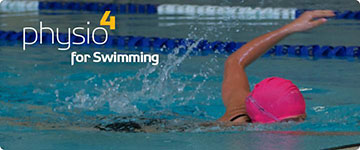
Compared to other sports, swimming has a relatively low risk of injury. However, the most common body part injured while swimming is the shoulder. Shoulder pain can be caused by muscle overuse, incorrect technique or swimming only one stroke during every workout. Whatever the reason, these factors can lead to shoulder discomfort and injury, most commonly rotator cuff tendinitis.
If you experience shoulder pain during or after swimming, your physiotherapist can help.
Chiara Singh (Surrey Memorial Hospital) is a triathlete who knows the value of swim techniques to race fast and remain injury-free.
Swim Tips to prevent injury, alleviate pain and keep you moving for life.
- Be mindful of body rotation.
Never swim with a “flat body” as this limits the rotation of the shoulder along the axis of the spine. Develop a symmetrical way to rotate your body for an efficient breathing pattern and this will greatly reduce the risk of shoulder injuries.
- Enter the water with a flat hand.
A hand directed outwards when entering the water leads to unhealthy internal rotation. This is one of the most common causes of acute pain in the shoulder as it overuses the muscles. It is best to enter the water with a flat hand, fingertips first.
- Maintain good posture.
The saying “shoulders back, chest forward” applies both in and out of the water. Hunched or rounded shoulders can lead to shoulder injuries and “cross-overs” in your stroke. Strengthening the muscles at the back of the shoulder and stretching those at the front will help prevent injury, and help you to swim faster.
- Incorporate bilateral breathing into your swim workout.
Breathing only on one side will develop the muscles on that side more than the other. This can eventually lead to shoulder problems. By breathing on both sides with every workout you can prevent this from happening.
And remember when swimming outdoors, never dive head first into water unless the depth is known. And, when swimming in lakes or oceans be aware of any natural hazards such as tides and rapids, and never swim alone.
To contact a physiotherapist for a stroke assessment or for an exercise program to help avoid or overcome shoulder injury, visit movingforlife.ca.

